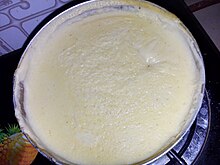Ogi (or Akamu) is a fermented cereal pudding and popular street food from Nigeria, typically made from maize, sorghum, or millet.[1][2][3][4] Traditionally, the grains are soaked in water for up to three days, before wet-milling or grinding and sieving to remove husks. The filtered cereal is then allowed to ferment for up to three days until sour. It is then boiled into a pap, or cooked to make a creamy pudding also known as Agidi or Eko.[5] It may be eaten with moin moin, acarajé or bread depending on individual choice.
 | |
| Alternative names | Akamu |
|---|---|
| Type | Pap or pudding |
| Place of origin | Nigeria |
| Region or state | West Africa |
| Main ingredients | Maize, sorghum or millet |
| Ingredients generally used | sugar |
| Variations | Uji in Kenya |

In Kenya the porridge is known as uji (not to be confused with ugali) and is generally made with millet and sorghum. It is commonly served for breakfast and dinner,[6][7][8] but often has a thinner gravy-like consistency.[9]
The fermentation of ogi is performed by various lactic acid bacteria including Lactobacillus spp and various yeasts including Saccharomyces and Candida spp.[1][10][11]
See also
edit- Boza - Fermented grain drink
- Fermentation in food processing
- List of African dishes
- Mageu - African fermented beverage
- Poi - Starchy Polynesian dish that is sometimes fermented
- Pozol - Fermented corn drink from the Americas
- Komfot Pap - Pap manufacturer in Nigeria
References
edit- ^ a b "Fermented Cereals - A Global Perspective". United Nations FAO. Retrieved 2006-07-22.
- ^ "Process of making Ogi (pap, akamu)". Vanguard News. 2017-04-26. Retrieved 2022-06-01.
- ^ Kenzap (2020-07-14). "AKAMU/OGI (PAP)". Diet Tech Africa. Retrieved 2022-06-01.
- ^ "Oloye Corn Meal - Akamu / Pap / Koko/ogi". My Sasun. Retrieved 2022-06-01.
- ^ "Ogi (pap)". Divine Foods Store Incorporated. Retrieved 2022-06-01.
- ^ "Lavidalocavora". Archived from the original on 2014-12-30. Retrieved 2015-01-08.
- ^ "UJI | Meaning & Definition for UK English | Lexico.com". Lexico Dictionaries | English. Archived from the original on June 1, 2022. Retrieved 2022-06-01.
- ^ Ekpa, Onu; Palacios-Rojas, Natalia; Kruseman, Gideon; Fogliano, Vincenzo; Linnemann, Anita R. (2019-10-03). "Sub-Saharan African Maize-Based Foods - Processing Practices, Challenges and Opportunities". Food Reviews International. 35 (7): 609–639. doi:10.1080/87559129.2019.1588290. ISSN 8755-9129. S2CID 155197863.
- ^ "Bella online".
- ^ Nago, Mathurin Coffi; Hounhouigan, Joseph D.; Akissoe, Noël; Zanou, Elisabeth; Mestres, Christian (June 1998). "Characterization of the Beninese traditional ogi, a fermented maize slurry: physicochemical and microbiological aspects". International Journal of Food Science & Technology. 33 (3): 307–315. doi:10.1046/j.1365-2621.1998.00169.x.
- ^ Omemu, Adebukunola Mobolaji; Okafor, Uchechukwu Ifeoma; Obadina, Adewale O.; Bankole, Mobolaji O.; Adeyeye, Samuel Ayofemi Olalekan (July 2018). "Microbiological assessment of maize ogi cofermented with pigeon pea". Food Science & Nutrition. 6 (5): 1238–1253. doi:10.1002/fsn3.651. PMC 6060903. PMID 30065825.